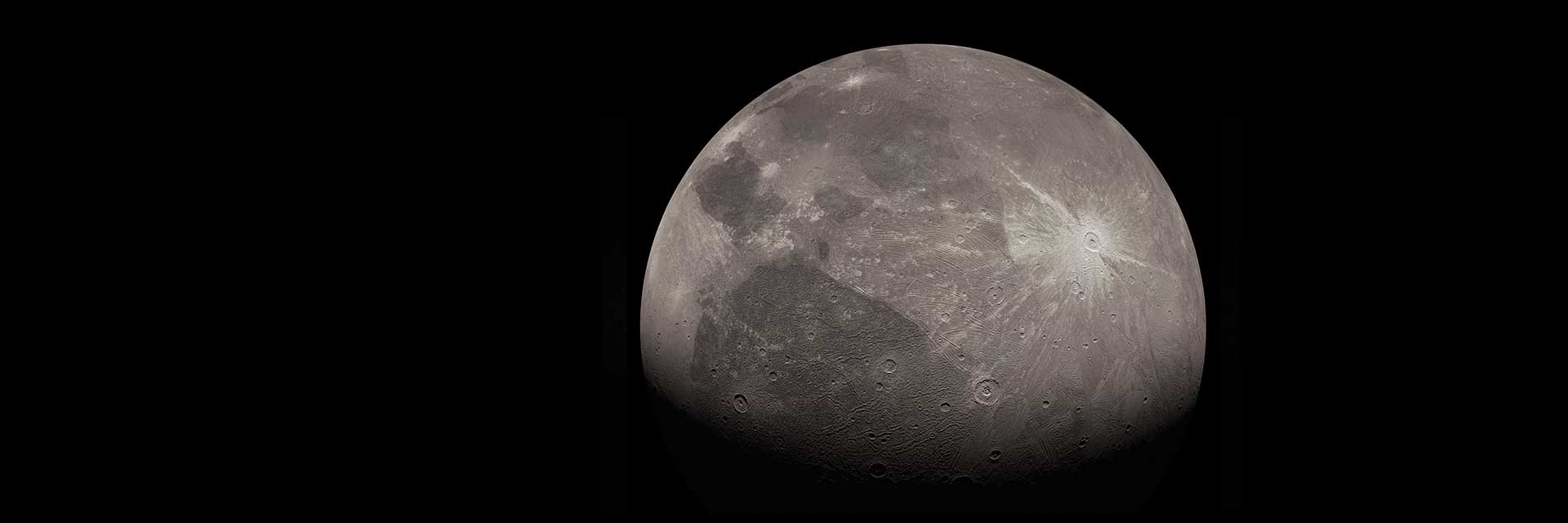Ganymede: Exploration

The discovery of Ganymede and Jupiter’s three other largest moons - Europa, Io, and Callisto - forever changed the way we view our solar system.
On Jan. 7, 1610, Italian astronomer Galileo Galilei was looking at Jupiter through his homemade telescope when he spotted what he thought were three small, bright stars near Jupiter. Soon, Galileo determined there were four “stars.” Within days, he had figured out that these points of light were actually moons orbiting Jupiter. These four moons were the first objects found to orbit something other than Earth or the Sun, providing strong evidence for the idea, known as the Copernican theory, that most celestial objects did not revolve around Earth.
The German astronomer Simon Marius may have observed the moons around the same time as Galileo, but Galileo is credited with the discovery. Galileo published his findings in March 1610 in a book titled “Sidereus Nuncius” or “The Starry Messenger.”

Galileo originally called Jupiter's moons the Medicean planets after his patrons, the Medici family. He also referred to the moons numerically as I, II, III, and IV. But it is the names that Simon Marius proposed for the moons – names suggested to him by fellow astronomer Johannes Kepler – that we use today: Io, Europa, Ganymede, and Callisto. The four moons collectively are referred to as the Galilean moons.
More than 360 years after they were discovered, NASA sent a spacecraft to study the Galilean moons. Pioneer 10 had its closest encounter with Jupiter on Dec. 3, 1973. It was the first spacecraft to obtain close-up images of Jupiter, and three of its largest moons: Ganymede, Callisto, and Europa. The spacecraft did not image Io.

Pioneer 11, the sister spacecraft to Pioneer 10, took the first images of Jupiter’s polar region, flying three times closer to Jupiter than Pioneer 10. The spacecraft flew closest to Jupiter on December 3, 1974, soaring about 26,570 miles (42,760 kilometers) above the planet's cloud tops – three times closer than Pioneer 10. The spacecraft passed within 430,200 miles (692,200 kilometers) of Ganymede and discovered a high electron current flow at Ganymede’s orbit.

Before NASA’s Voyager 1 and Voyager 2 arrived at Jupiter in 1979, astronomers thought that Saturn's moon Titan was the largest in the solar system. But measurements from the Voyager probes showed Ganymede is bigger than Titan, even bigger than Mercury and Pluto. Images from Voyager 1 also revealed that Ganymede had two distinct types of terrain – cratered and grooved – suggesting to scientists that the moon’s entire icy crust has been under tension from global tectonic processes.

The Galileo spacecraft, the first to orbit Jupiter, made the major discovery that Ganymede has its own magnetosphere – a region of charged particles that surrounds some planets but had never before been found around a moon. Galileo made several flybys of Ganymede with multiple instruments collecting data on the moon.
Galileo even captured sounds of whistling and static caused by Ganymede's magnetosphere. The probe flew within 519 miles (835 kilometers) of Ganymede, sending back stunning close-up images showing ancient cratered ice fields adjacent to or overlain by younger ice volcanic plains, ridged ice mountains, deep furrows, and smooth broad basins that are products of tectonic forces.

During Galileo’s extended mission, NASA’s Cassini spacecraft flew by Jupiter on its way to Saturn. For a few weeks, both spacecraft observed Jupiter together. Cassini sent back amazing images of Ganymede dwarfed by Jupiter as it made its closest approach to the planet in December 2000.

NASA’s New Horizons spacecraft came within 1.4 million miles (2.3 million kilometers) of Jupiter in 2007 as it headed to Pluto. It was the eighth spacecraft to visit Jupiter. As it approached, New Horizons took images of Ganymede, Callisto, Io, and Europa. It captured nearly 700 observations, including images of Ganymede on Feb. 27, 2007.

NASA’s Hubble Space Telescope has provided important contributions to what we know about Ganymede – including the best evidence yet that Ganymede may have an underground saltwater ocean, opening up the possibility that Jupiter’s largest moon is another candidate for life beyond Earth. Because Ganymede has a magnetic field, it has auroras. Since Ganymede is close to Jupiter, its magnetic field lies within, or is embedded in, Jupiter’s magnetic field - a field within a field. (Ganymede is the primary scientific target of ESA’s JUICE mission which will also study Jupiter’s moons Europa, and Callisto.)
When Jupiter’s magnetic field changes, the auroras on Ganymede also change, “rocking” back and forth. By watching the rocking motion of the two auroras, scientists using Hubble were able to determine that a large amount of saltwater exists beneath Ganymede’s crust affecting its magnetic field.
During its June 7, 2021, flyby Juno captured its best images yet of Ganymede, flying closer to Jupiter’s largest moon than any spacecraft in more than two decades.
The photos show the surface of Ganymede in remarkable detail, including craters, clearly distinct dark and bright terrain, and long structural features possibly linked to tectonic faults.

“This is the closest any spacecraft has come to this mammoth moon in a generation,” said Juno Principal Investigator Scott Bolton of the Southwest Research Institute in San Antonio. “We are going to take our time before we draw any scientific conclusions, but until then we can simply marvel at this celestial wonder.”
